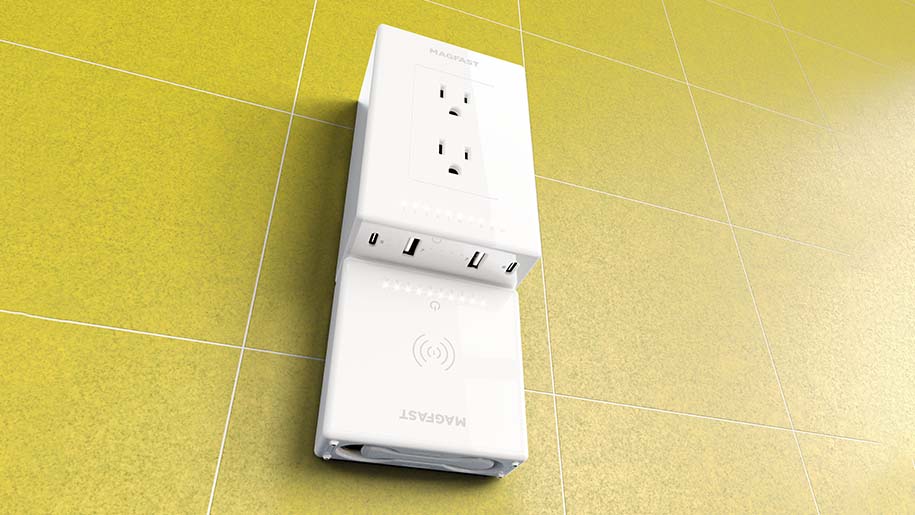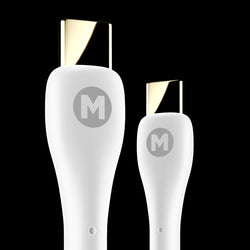
What Does a Surge Protector Do to Defend Charging Devices?
A surge protector is designed to shield your electronic devices from rises in power. Without a surge protector, electronic devices that are plugged into the mains can be harmed. A large power surge can ‘fry’ the circuits of your electronics or even melt the plastic, irreversibly damaging them to the point that they can no longer be used. A surge protector can prevent this from happening. In this guide, we investigate exactly how surge protectors work and why they’re essential when charging your devices.
What Does a Surge Protector Do?
When there is a large increase in electricity above the normal voltage, the surge protector will divert that power away from your devices, usually through a grounding wire. It uses a metal oxide varistor (MOV) that monitors the voltage levels and automatically adjusts its resistance accordingly. When there is extra voltage, the MOV absorbs and dissipates the heat that comes with the extra power, preventing it from going into your devices and damaging them.
MOV is known as a ‘self-sacrificing’ component. This is because it will take the damage and weaken over time, rather than letting power surges harm your devices. This means that over time, usually many years but dependent on how many power surges it faces, the MOV will deteriorate completely. Surge protectors have been designed this way in order to protect your devices and prevent them from deteriorating.
Are All Power Strips Surge Protectors?
Surge protectors are typically sold as power strips that you can plug multiple devices into. However, not all power strips are equipped with surge protectors. They will both look similar, but only the surge protector will protect your devices from power surges. A normal power strip will not have the ability to dissipate any power that comes from a surge, so using one could damage your devices if there is an increase in voltage.
What is a Power Surge?
A power surge is when the usual flow of electricity is disrupted in some way, causing the amount of voltage to be increased over the standard 120 volts. There will usually be a change in pressure that can cause an increase in the current that flows to your outlet. If you have devices attached to this outlet, the increase in power can overheat them and cause damage.
You will usually not notice a power surge has happened, as most will be minor. A household can experience many electrical surges throughout the year, with no damage caused. You will probably only notice a power surge has happened when a device stops working.
What’s the Difference between a Power Surge and a Power Spike?
A power surge is when the increase in voltage lasts for more than three nanoseconds. A power spike is when the increase in voltage lasts for one or two nanoseconds. Both can cause irrevocable damage to your devices, even though the voltage increase might only last for billionths of a second.
What Causes Power Surges?
Lightning Strikes
Power surges can occur for a variety of reasons. One of the most well-known causes is lightning strikes. If lightning strikes on or near a power line, whether it be underground, in a building, or between poles, the electrical pressure will be increased by millions of volts. Most surge protectors aren’t able to protect devices against this large of a power surge, so it’s always best to unplug your devices in a power storm. If you need to charge your devices, you should use a portable power bank that isn’t plugged into the mains.
High Power Equipment
Power surges caused by lightning are very rare. A more common cause of power surges is the use of electrical devices that require a lot of power. Equipment such as air conditioners, refrigerators and space heaters need a large amount of energy to operate the compressors and motors. They will require more power when they’re turned on or turned off, which can unsettle the steady flow of voltage in the electrical system. This can, in turn, create a power surge that could damage devices that aren’t secured with a surge protector. These types of power surge aren’t as severe as lightning strikes, but they can still damage components inside electrical devices, especially when the damage occurs consistently over a period of time.
Dirty Power
‘Dirty power’ is the term that’s used for when the electricity running in the circuit is abnormal in some way. It will usually have electromagnetic noise that can interfere with your power supply and cause issues, such as variations in voltage and power surges. This noise can come from various sources, such as the power lines or even inside your property. Dirty power is contrasted with clean power, where there is no electrical noise and no spikes or drops in voltage.
Why Do I Need a Surge Protector to Safeguard My Devices When Charging?
You might think that you only have to worry about the uncommon and large power surges caused by lightning strikes. These will, of course, damage your devices due to the large increase in voltage. However, small power surges will happen regularly. Over time, the delicate components present in your smartphone and other modern devices can become damaged by the overheating and additional strain that occurs during power surges. This will be a problem if you routinely plug your phone into a mains outlet to charge it overnight, for example. Whilst you won’t notice damage after the first small power surge, regular surges will cause the components to deteriorate.
Using a surge protector for your high-end electronics, like your smartphone or laptop, will help to extend the life of the device. The surge protector will block the excess heat that comes from power surges reaching your device, preventing any damage or deterioration.
Do Standard Wall Outlets Include Surge Protection?
No, most wall outlets do not come with surge protection as standard. A surge protector will usually have to be bought separately to ensure your devices are kept safe from surges in power. These will usually come as power strips that can be plugged into the outlet and have multiple devices plugged into them, or sometimes you can get a single-outlet surge protector that will sit flush against the wall.
MAGFAST’s Safety Promise
MAGFAST will never compromise on safety. Our premium chargers are rigorously tested to Underwriters Laboratories (UL) standards, meaning that the safety components in them will protect your devices and help to prolong their lifespan. It also means that the MAGFAST device itself won’t overheat or set on fire, which can sometimes occur with lower quality and cheaper surge protectors that haven’t been tested to the same standards.
MAGFAST chargers have built-in surge protection using MOV to absorb and dissipate the heat that can come from surges in power. This means that your devices will be protected when charging with a MAGFAST charger. In the event of a power surge, the extra power and heat will be redirected away from your devices, preventing any of the delicate components from taking on any damage. We’re so confident in our MAGFAST chargers that our standard 3-year warranty, MAGFAST Care, also includes up to $10,000 for connected devices.
Discover MAGFAST’s family of premium chargers today.
- What Does a Surge Protector Do to Defend Charging Devices?
- What Does a Surge Protector Do?
- Are All Power Strips Surge Protectors?
- What is a Power Surge?
- What’s the Difference between a Power Surge and a Power Spike?
- What Causes Power Surges?
- Why Do I Need a Surge Protector to Safeguard My Devices When Charging?
- Do Standard Wall Outlets Include Surge Protection?
- MAGFAST’s Safety Promise
America's highest-rated smart phone cable ...



